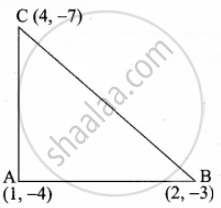Advertisements
Advertisements
Question
Show that the given points form a right angled triangle and check whether they satisfy Pythagoras theorem
A(1, – 4), B(2, – 3) and C(4, – 7)
Solution
The vertices are A(1, – 4), B(2, – 3) and C(4, – 7)
Slope of a line = `(y_2 - y_1)/(x_2 - x_1)`
Slope of AB = `(-3 + 4)/(2 - 1) = 1/1` = 1
Slope of BC = `(-7 + 3)/(4 -2) = (-4)/2` = – 2
Slope of AC = `(-7 + 4)/(4 - 1) = - 3/3` = – 1
Slope of AB × Slope of AC = 1 × – 1 = – 1
∴ AB is ⊥r to AC
∠A = 90°
∴ ABC is a right angle triangle
Verification:
Distance = `sqrt((x_2 - x_1)^2 + (y_2 - y_1)^2`
AB = `sqrt((2 - 1)^2 + (-3 + 4)^2`
= `sqrt(1^2 + 1^2)`
= `sqrt(2)`
BC = `sqrt((4 - 2)^2 + (- 7 + 3)^2`
= `sqrt((2)^2 + (- 4)^2`
= `sqrt(4 + 16)`
= `sqrt(20)`
AC = `sqrt((4 - 1)^2 + (-7 + 4)^2`
= `sqrt(3^2 + (- 3)^2`
= `sqrt(9 + 9)`
= `sqrt(18)`
BC2 = AB2 + AC2
`(sqrt(20))^2 = (sqrt(2))^2 + (sqrt(18))^2`
20 = 2 + 18
20 = 20
⇒ Pythagoras theorem verified
APPEARS IN
RELATED QUESTIONS
What is the slope of a line whose inclination with positive direction of x-axis is 90°
What is the inclination of a line whose slope is 0
What is the slope of a line perpendicular to the line joining A(5, 1) and P where P is the mid-point of the segment joining (4, 2) and (–6, 4).
The line through the points (– 2, a) and (9, 3) has slope `-1/2` Find the value of a.
The line through the points (– 2, 6) and (4, 8) is perpendicular to the line through the points (8, 12) and (x, 24). Find the value of x.
Show that the given points form a right angled triangle and check whether they satisfy Pythagoras theorem.
L(0, 5), M(9, 12) and N(3, 14)
Show that the given points form a parallelogram:
A(2.5, 3.5), B(10, – 4), C(2.5, – 2.5) and D(– 5, 5)
If the points A(2, 2), B(– 2, – 3), C(1, – 3) and D(x, y) form a parallelogram then find the value of x and y.
The slope of the line joining (12, 3), (4, a) is `1/8`. The value of ‘a’ is
The slope of the line which is perpendicular to a line joining the points (0, 0) and (− 8, 8) is
